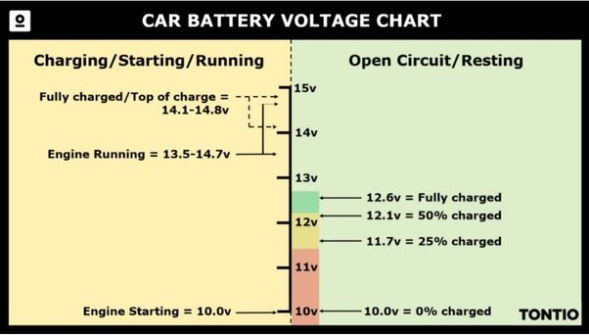Ignite Your Ride: Finding the Perfect Voltage Match!
When it comes to kick-starting your Car, one of the most important factors to consider is the voltage of your battery. Having the right voltage can make all the difference in getting your engine revved up and ready to go. In this ultimate guide, we will delve into the world of voltage and help you determine the ideal match for your ride.

Image Source: quoracdn.net
First and foremost, it’s essential to understand what voltage actually is. Voltage is the measure of electrical potential difference between two points in a circuit. In simpler terms, it’s the force that pushes electrical current through your car’s system. When it comes to starting your car, having the right amount of voltage is crucial for a smooth and quick ignition.
The standard voltage for most car batteries is 12 volts. This is what you would typically find in a regular car battery, and it is sufficient for most vehicles. However, it’s essential to check your specific car model and manufacturer recommendations to ensure you are using the correct voltage for your engine.
If you find that your car is struggling to start, it could be due to a voltage issue. If your battery is low on voltage, it may not have enough power to turn over the engine and get your car running. This is where finding the perfect voltage match becomes essential.
To determine the ideal voltage for your car, you can start by checking the specifications provided by your car manufacturer. They will typically recommend the optimal voltage range for your specific make and model. Additionally, you can use a multimeter to measure the voltage of your battery and ensure it is within the recommended range.
When selecting a new battery for your car, be sure to choose one that matches the recommended voltage for your vehicle. Opting for a battery with too high or too low voltage can lead to starting issues and potential damage to your engine.
Another factor to consider when it comes to voltage is the temperature. In colder weather, your battery may lose some of its power, making it harder to start your car. This is why it’s crucial to ensure your battery has the right voltage to compensate for any temperature fluctuations.
In addition to the voltage of your battery, it’s also essential to check the voltage of your spark plugs. Spark plugs play a crucial role in igniting the fuel-air mixture in your engine, and having the correct voltage is vital for optimal performance. Be sure to check the manufacturer’s recommendations for your spark plug voltage to ensure they are working efficiently.
Overall, finding the perfect voltage match for your car is essential for a smooth and quick start. By understanding the role of voltage in your car’s ignition system and taking the necessary steps to ensure you have the right voltage, you can rev up your engine and hit the road with confidence. So, ignite your ride with the perfect voltage match and enjoy a smooth and efficient start every time!
Power Up Your Engine: The Key to Quick Starts!
Revving up your engine and getting ready to hit the road can be an exciting experience. But what happens when your Car just won’t start? It can be frustrating and inconvenient, especially when you’re in a hurry or far away from Home. That’s why it’s crucial to understand the importance of voltage when it comes to kick-starting your car.
Voltage plays a significant role in the starting process of your engine. It is the electrical force that powers the starter motor and ignites the fuel in your car’s engine. Without the proper voltage, your engine may struggle to start, or not start at all. That’s why it’s essential to make sure you have the right amount of power to get your engine up and running quickly.
So, how do you determine the ideal voltage to kick-start your car? Here are a few tips to help you power up your engine and ensure quick starts every time:
1. Check Your Battery
The first step in ensuring quick starts for your car is to check the condition of your battery. A weak or dead battery will not provide enough power to start your engine. Make sure your battery is fully charged and in good working condition. If you notice any corrosion or damage to your battery, it may be time for a replacement.
2. Test Your Alternator
The alternator is responsible for charging your battery while the engine is running. If your alternator is not functioning properly, your battery may not be getting the power it needs to start your engine. Test your alternator to ensure it is working efficiently and providing the right amount of voltage to your battery.
3. Use a Multimeter
A multimeter is a handy tool that can help you measure the voltage of your battery and electrical system. By using a multimeter, you can determine if your battery is fully charged and if your electrical system is providing the necessary voltage to start your engine. This can help you pinpoint any issues with your battery or electrical system that may be causing starting problems.
4. Consider Upgrading Your Battery
If you find that your battery is not providing enough power to kick-start your engine, it may be time to consider upgrading to a higher voltage battery. A higher voltage battery can provide the extra power needed to start your engine quickly and efficiently, especially in cold weather or when your engine is under heavy load.
5. Keep Your Engine Well-Maintained
Regular maintenance is key to ensuring your engine starts quickly and smoothly. Make sure to check your spark plugs, fuel system, and ignition system regularly to ensure they are in good working condition. Keeping your engine well-maintained can help prevent starting issues and keep your car running smoothly.
By following these tips and understanding the importance of voltage when it comes to kick-starting your car, you can rev up your engine and enjoy quick starts every time. So, next time you hit the road, make sure your car is powered up and ready to go with the right amount of voltage to kick-start your engine.
Get the Spark You Need: Voltage Tips for Cars!
Rev Up Your Engine: The Ultimate Guide to Determining the Ideal Voltage to Kick-start Your Car
Get the Spark You Need: Voltage Tips for Cars!
When it comes to kick-starting your car, having the right voltage is essential. Without the proper voltage, your engine may struggle to start, causing frustration and potential damage. In this article, we will explore some voltage tips for cars to help you rev up your engine with ease!
First and foremost, it is important to understand what voltage is and why it is crucial for starting your car. Voltage is essentially the electrical pressure that flows through your car’s battery to power the engine and other components. Without the right amount of voltage, your car may not start at all or may start sluggishly.
So, how can you ensure that you have the right voltage to kick-start your car? One tip is to regularly check your car’s battery voltage using a multimeter. This tool can help you determine if your battery is fully charged and ready to go. A healthy car battery typically has a voltage reading of around 12.6 volts when fully charged.
Another voltage tip for cars is to keep an eye on your car’s dashboard for any warning lights indicating low voltage. These warning lights may include the battery light or the check engine light. If you see these lights come on, it is a good indication that your car may be experiencing voltage issues.
In addition to checking your battery voltage and monitoring warning lights, it is also important to keep your car’s electrical system in top condition. This means regularly Inspecting and maintaining your car’s wiring, fuses, and other components to ensure that they are all functioning properly and not causing any voltage drops.
When it comes to jump-starting your car, it is crucial to use the correct voltage to avoid damaging your car’s electrical system. Always use a compatible jump starter or jumper cables with the right voltage rating for your car. Using the wrong voltage can potentially cause a short circuit or other damage.
Lastly, if you are unsure about the voltage requirements for your car, it is always best to consult your car’s owner’s manual or a professional mechanic. They can provide you with specific recommendations for your car’s make and model to ensure that you are using the right voltage for optimal performance.
By following these voltage tips for cars, you can ensure that your car is always ready to go with the spark it needs to kick-start your engine. So, rev up your engine with confidence and hit the road knowing that you have the right voltage to power your ride!
Revving with Precision: The Ultimate Voltage Guide!
Are you ready to rev up your engine and hit the road with confidence? Determining the ideal voltage to kick-start your Car is essential for a smooth and efficient driving experience. In this ultimate voltage guide, we will explore everything you need to know to ensure your car is powered up and ready to go.
Voltage plays a crucial role in starting your car’s engine. It is the electrical force that powers the spark plugs, igniting the fuel in the combustion chamber and starting the engine. Without the right voltage, your car may struggle to start, leading to frustrating delays and potential damage to your engine.
To determine the ideal voltage for your car, you first need to consult your owner’s manual. This will provide you with the manufacturer’s recommendations for the optimal voltage range for your specific make and model. It is important to follow these guidelines to ensure your car starts smoothly and efficiently.
In addition to the manufacturer’s recommendations, there are a few key factors to consider when determining the ideal voltage for your car. These include the size and type of your engine, the age of your car, and any modifications or upgrades that have been made to your vehicle.
For larger engines, such as those found in trucks or SUVs, a higher voltage may be required to ensure a quick and powerful start. Conversely, smaller engines may only require a lower voltage to get up and running. It is important to take these factors into account when determining the ideal voltage for your car.
The age of your car can also impact the ideal voltage needed to start your engine. Older cars may require a higher voltage to compensate for wear and tear on the electrical system, while newer cars may be more efficient and require less voltage to start.
If you have made any modifications or upgrades to your vehicle, such as installing a high-performance ignition system or aftermarket Accessories, you may need to adjust the voltage accordingly. These modifications can increase the power demands on your car’s electrical system, requiring a higher voltage to start the engine.
In addition to considering the ideal voltage for your car, it is important to regularly check and maintain your car’s electrical system to ensure it is functioning properly. This includes checking the battery, alternator, and spark plugs for any signs of wear or damage.
A healthy electrical system is essential for starting your car and keeping it running smoothly. Regular maintenance and Inspections can help prevent potential issues and ensure your car is always ready to hit the road.
In conclusion, determining the ideal voltage to kick-start your car is essential for a smooth and efficient driving experience. By following the manufacturer’s recommendations, considering key factors such as engine size and age, and maintaining your car’s electrical system, you can ensure your car is powered up and ready to go. So rev up your engine and hit the road with confidence!
how much voltage to start a car






